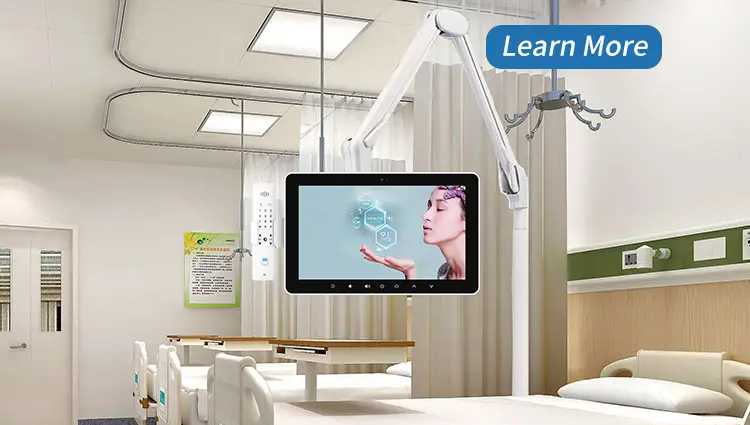In the medical field, patient monitoring systems are an important tool to ensure patient safety and improve medical quality. This article provides you with a comprehensive patient monitoring system buying guide designed to address your pain points and help you find the best monitoring system for your medical needs.
Product information
When purchasing a patient monitoring system, you need to consider not only the brand and model, such as Philips, GE Healthcare, Saintwaytech, etc., but also the reliability, ease of use and scalability of the system. For example, some systems may support remote monitoring, allowing doctors or nurses to access a patient’s vital sign data from a different location. In addition, the user interface of the system should also be intuitive and easy to operate, so that medical staff can quickly identify and respond to changes in the patient’s health status.
Technical specifications
Technical specifications of patient monitoring systems are critical to ensuring patient safety and quality of care. In addition to basic vital sign monitoring parameters, modern monitoring systems may include advanced features such as trend analysis, alarm systems, and integrated cardiac monitoring capabilities. These features can help healthcare professionals manage patients more efficiently, especially during emergencies.
Application scenarios
The application scenarios of patient monitoring systems are very wide. In an intensive care unit (ICU), the monitoring system is usually connected to a central station to monitor the vital signs of multiple patients in real time. In the operating room, monitoring systems are used for patient management during surgery and post-operative recovery. In addition, with the development of telemedicine technology, home monitoring systems are becoming more and more popular, allowing patients to conduct long-term health monitoring in the comfort of their own homes.
Purchasing needs
When determining purchasing needs, both healthcare organizations and individual users should consider the long-term value and total cost of ownership of the system. This includes the initial purchase price, maintenance fees, possible upgrade costs, and the cost of training healthcare workers to use the system. Choosing a monitoring system with good customer support and upgrade paths can help reduce long-term costs.
User evaluation
User reviews can provide valuable information about the actual performance of a patient monitoring system. Reviewing professional medical device review websites, industry reports, and case studies from healthcare organizations can help you understand the benefits and potential limitations of different systems.
Accessories and compatibility
Accessories and compatibility are key factors in ensuring smooth integration of patient monitoring systems into existing healthcare environments. For example, some monitoring systems may require specific sensors or cables to monitor specific vital signs. Ensuring the compatibility and availability of these accessories is critical to the seamless operation of the system.
After-sales service and warranty
When choosing a patient monitoring system, it is crucial to understand the after-sales service and warranty policies offered by the manufacturer. This includes warranty duration, warranty coverage, technical support and repair services. Choosing a manufacturer with a good reputation and service record ensures your investment is protected and you receive prompt support when needed.
User solutions
Patient monitoring systems address many solutions in healthcare, including improving patient safety, reducing medical errors, increasing healthcare worker productivity, and improving the quality of patient care. Through real-time monitoring and alerting systems, monitoring systems can help healthcare professionals respond quickly to changes in a patient’s health status, thereby improving overall patient outcomes.
What is an example of a patient monitoring system?
An example of a specific patient monitoring system is the MT2199, an advanced monitoring system that can monitor multiple patient vital signs simultaneously, including heart rate, blood pressure, oxygen saturation, and respiratory rate. It features a touch-screen interface and trend charts, allowing healthcare professionals to easily track patient health and quickly identify any abnormalities.
What is a patient health monitoring system?
A patient health monitoring system is a medical device used to continuously monitor a patient’s vital signs and health status. These systems can monitor various parameters such as heart rate, blood pressure, respiratory rate, blood oxygen saturation, body temperature, etc. to help medical staff assess the patient’s health status and take intervention measures when necessary.
What are the 7 parameters of patient monitor?
The seven main parameters typically monitored by patient monitoring systems include:
Heart Rate
Blood Pressure
Respiratory Rate
Oxygen Saturation
Temperature
Electrocardiogram (ECG/EKG)
Non-invasive Blood Pressure
Why do we need patient monitoring system?
We need patient monitoring systems because they provide real-time, continuous data on patient health status, allowing healthcare professionals to make timely treatment decisions. Monitoring systems help prevent medical errors, increase patient safety, and improve overall patient outcomes. In addition, monitoring systems can also improve the efficiency of medical institutions, reduce labor costs, and improve patient satisfaction with medical services.
Conclusion: With this buying guide, we hope to help you find the best patient monitoring system for your medical needs. I wish you a smooth purchase and find satisfactory professional equipment!

